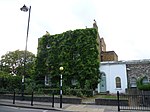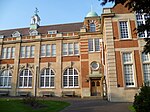68 Silver Street
Buildings and structures in the London Borough of EnfieldEnfield, LondonGrade II listed buildings in the London Borough of EnfieldGrade II listed houses in LondonLondon building and structure stubs

White Lodge, 68 Silver Street is a grade II listed building in Silver Street, Enfield, London. It was built in around the 17th century with later amendments. It was the home of Jacob Vale Asbury, Charles Lamb's doctor, and later of Joseph Whitaker, the publisher and founder of Whitaker's Almanack who lived at the house from 1862 until his death in 1895.
Excerpt from the Wikipedia article 68 Silver Street (License: CC BY-SA 3.0, Authors, Images).68 Silver Street
Silver Street, London Southbury (London Borough of Enfield)
Geographical coordinates (GPS) Address Nearby Places Show on map
Geographical coordinates (GPS)
| Latitude | Longitude |
|---|---|
| N 51.6542 ° | E -0.0809 ° |
Address
White Lodge Surgery
Silver Street 68
EN1 3EP London, Southbury (London Borough of Enfield)
England, United Kingdom
Open on Google Maps










